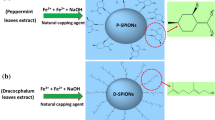Abstract
Modified magnetic starch nanoparticles (FA-StNP@Fe2O3) were synthesized by conjugating folic acid (FA-PEG-NH2) onto the surface of magnetic starch nanoparticles (StNP@Fe2O3) prepared by reverse microemulsion method. The synthesized FA-StNP@Fe2O3 was investigated by transmission electron microscopy and zeta potential analysis. The average size of its well dispersed particles was 250 nm. The iron concentration of 2 mg/g was detected by phenanthroline method. Placing FA-StNP@Fe2O3 nanoparticles in the alternating magnetic field for 30 min resulted in an increase in the suspension temperature from ambient temperature (37°C) to a value between 42°C and 43°C. Co-cultured nanoparticles and Hela cell line or normal HUEC-12 cell line, and the biological effects at the cellular level were investigated in the alternating magnetic field using MTT assay, Hochest-PI double staining and flow cytometry analysis. Experimental results showed that FA-StNP@Fe2O3 within acertain concentration range has no obvious effect on cell proliferation. When treated in the magnetic field, apoptosis rate on Hela induced by FA-StNP@Fe2O3 was 13.4%. Prussian blue staining analysis confirmed that the nanoparticles modified with folic acid had improved ability in tumor cell-targeting, and therefore, potential applications in biomedical and magnetocaloric areas. It is expected be applied in tumor targeting therapy in the near future.
Similar content being viewed by others
References
Saini S, Sharma R, Baron R L, et al. Multicentre dose-ranging study on the efficacy of USPIO ferumoxtran-10 for liver MR imaging. Clin Radiol. 2000, 55: 690–695
Gupta A K, Gupta M. Synthesis and surface engineering of iron oxide nanoparticles for biomedical applications. Biomaterials, 2005, 26: 3995–4021
Ma Y J, Li H, Yan Z B, et al. Study on the cell apoptosis induced by intracellular hyperthermia in human lung adenocarcinoma SPC-A1 Cells (in Chinese). J Biomed Eng, 2007, 24: 1305–1308
Xiao X X, He Q Q, Huang K L, et al. Possible magnetic multifunctional nanoplatforms in medicine. Med Hypotheses, 2007, 68: 680–682
Nanz D, Weishaupt D, Quick H H, et al. TE-switched double-contrast enhanced visualization of vascular system and instruments for MR-guided interventions. Magn Reson Med, 2000, 43: 645–648
Xiao S Y, Tong C Y, Liu X M, et al. Preparation of folate-conjugated starch nanoparticles and its application to tumor-targeted drug delivery. Chin Sci Bull, 2006, 51: 1693–1697
Liang B, He M L, Xiao Z P, et al. Synthesis and characterization of folate-PEG-grafted-hyperbranched-PEI for tumor-targeted gene delivery. Biochem Biophys Res Commun, 2008, 367: 874–880
Ana G, Carmen R L, Edison L S, et al. Microspheres containing lipid/chitosan nanoparticles complexes for pulmonary delivery of therapeutic proteins. Eur J Pharm Biopharm, 2008, 69: 83–93
Zhang L K, Hou S X, Mao S J, et al. Study on the tumor cell targetability of folate-conjugated albumin nanoparticles (in Chinese). Si Chuan Da Xue Xue Bao Yi Xue Ban, 2004, 35: 165–168
Sun H K, Ji H J, Cheol O J, et al. Folate receptor mediated intracellular protein delivery using PLL.PEG.FOL conjugate. J Control Release, 2005, 103:625–634
Raynal I, Rrigent P, Peyramaure S, et al. Macrophage endocytosis of superparamagnetic iron oxide nanoparticles: mechanisms and comparison of ferrumoxides and ferrumoxtran-10. Invest Radiol, 2004, 39: 56–63
Petri-Finka A, Chastellaina M, Juillerat-Jeanneretb F, et al. Development of functionalized superparamagnetic iron oxide nanoparticles for interaction with human cancer cells. Biomaterials, 2005, 26: 2685–2694
Zhang Lin, Wu W H, Wang D P, et al. Thermomagnetic effect and cytotoxicity of MnZn ferrite nanoparticles Cin Chinese. Chin J Biomed Eng, 2008, 27: 122–127
Liao H D, Yuan L, Tong C Y, et al. Immobilization of cellulose based on polyvingl alcohol/Fe2O3 nanoparticles (in Chinese). Chem J Chin Univ, 2008, 29: 1564–1568
Zhang Y, Zhang J. Surface modification of monodisperse magnetite nanoparticles for improved intracellular uptake to breast cancer cells. J Colloid Interface Sci, 2005, 283:352–357
Author information
Authors and Affiliations
Corresponding authors
Additional information
Supported by the Key Program for Science and Technology of Hunan Province (Grant No. 03NKY1001) and Key Construction Program of the National “985” Project.
About this article
Cite this article
Zheng, Y., Tong, C., Wang, B. et al. Development and application of tumor-targeting magnetic nanoparticles FA-StNP@Fe2O3 for hyperthermia. Chin. Sci. Bull. 54, 2998–3004 (2009). https://doi.org/10.1007/s11434-009-0422-x
Received:
Accepted:
Published:
Issue Date:
DOI: https://doi.org/10.1007/s11434-009-0422-x




